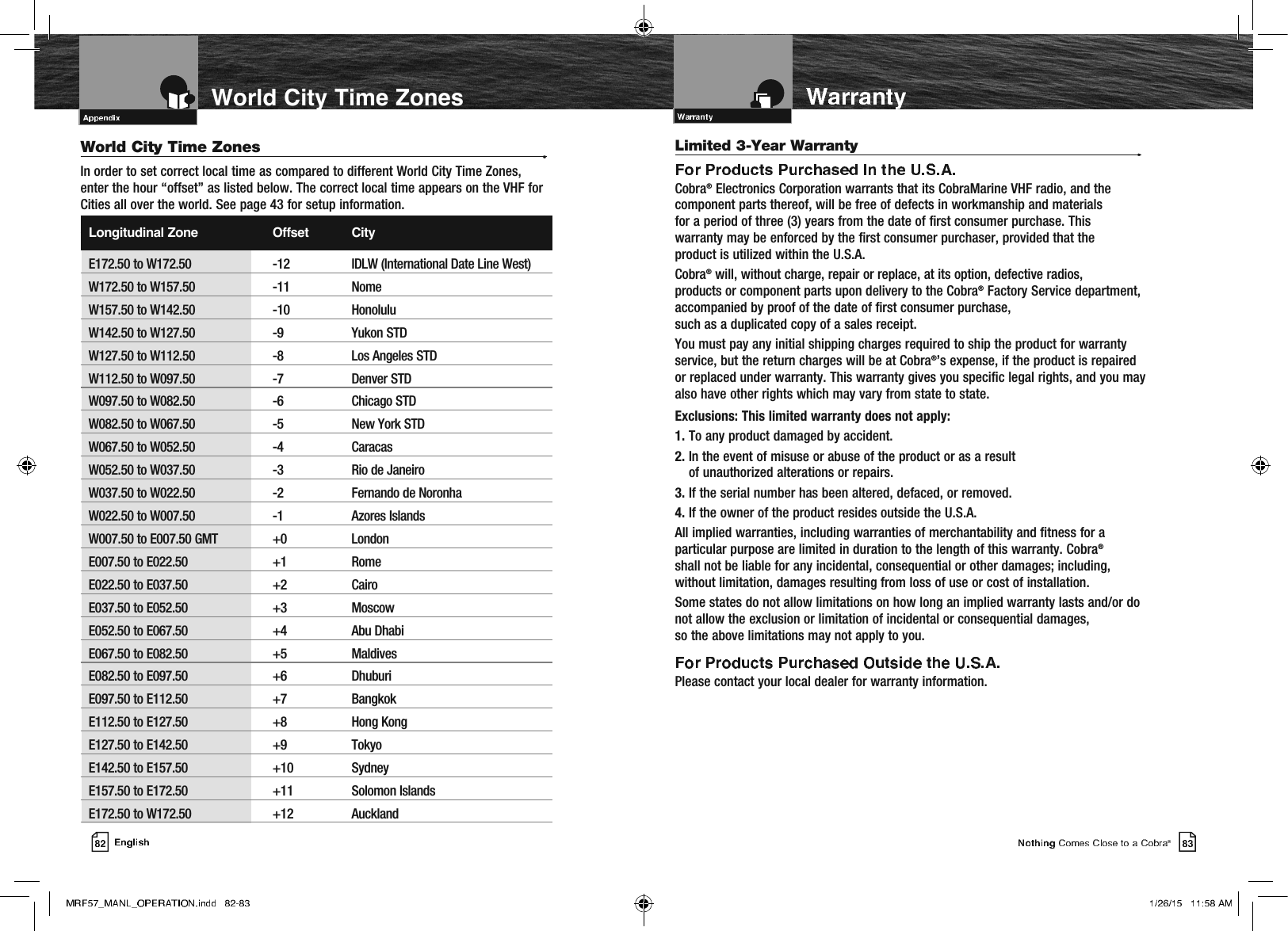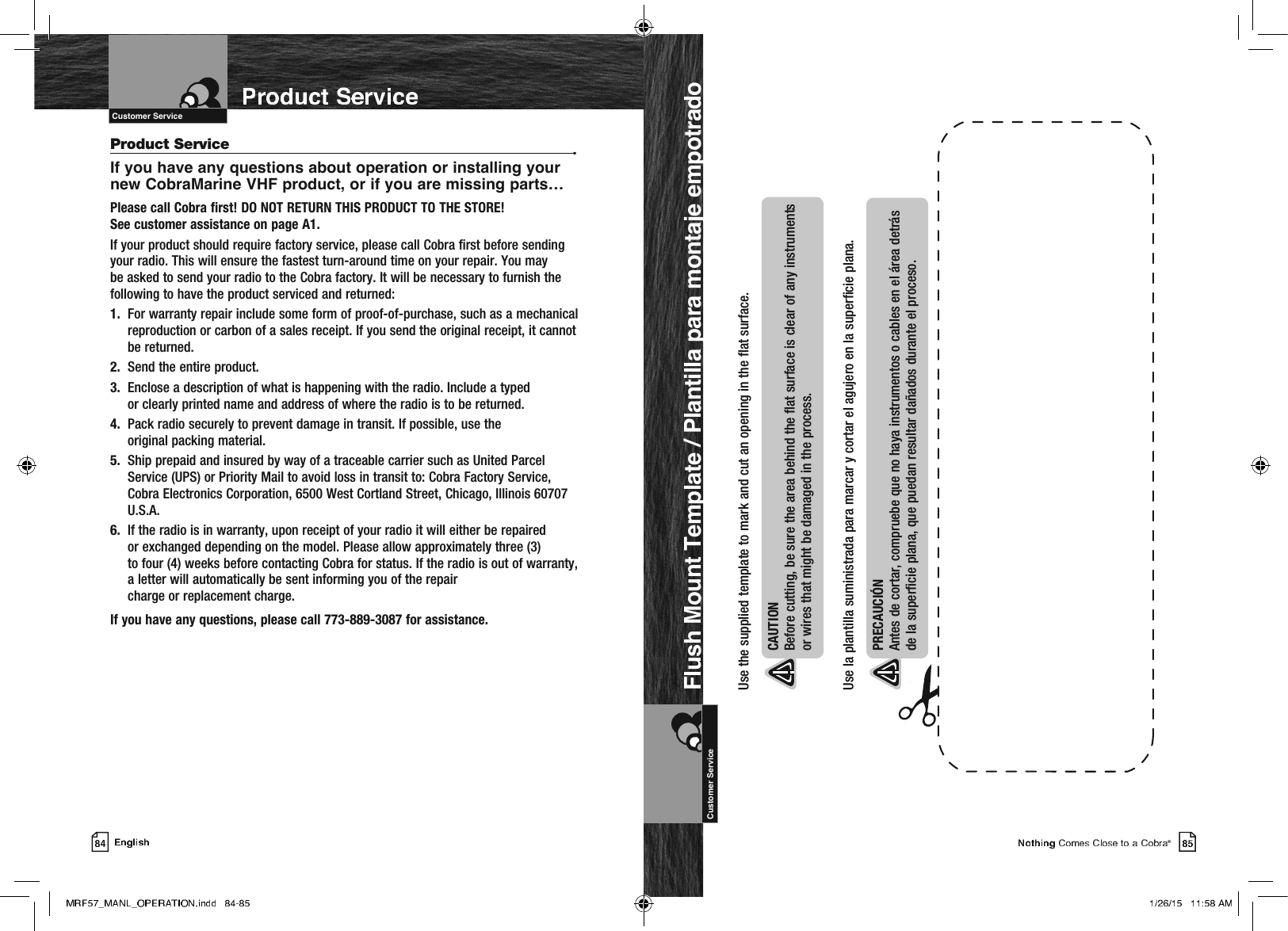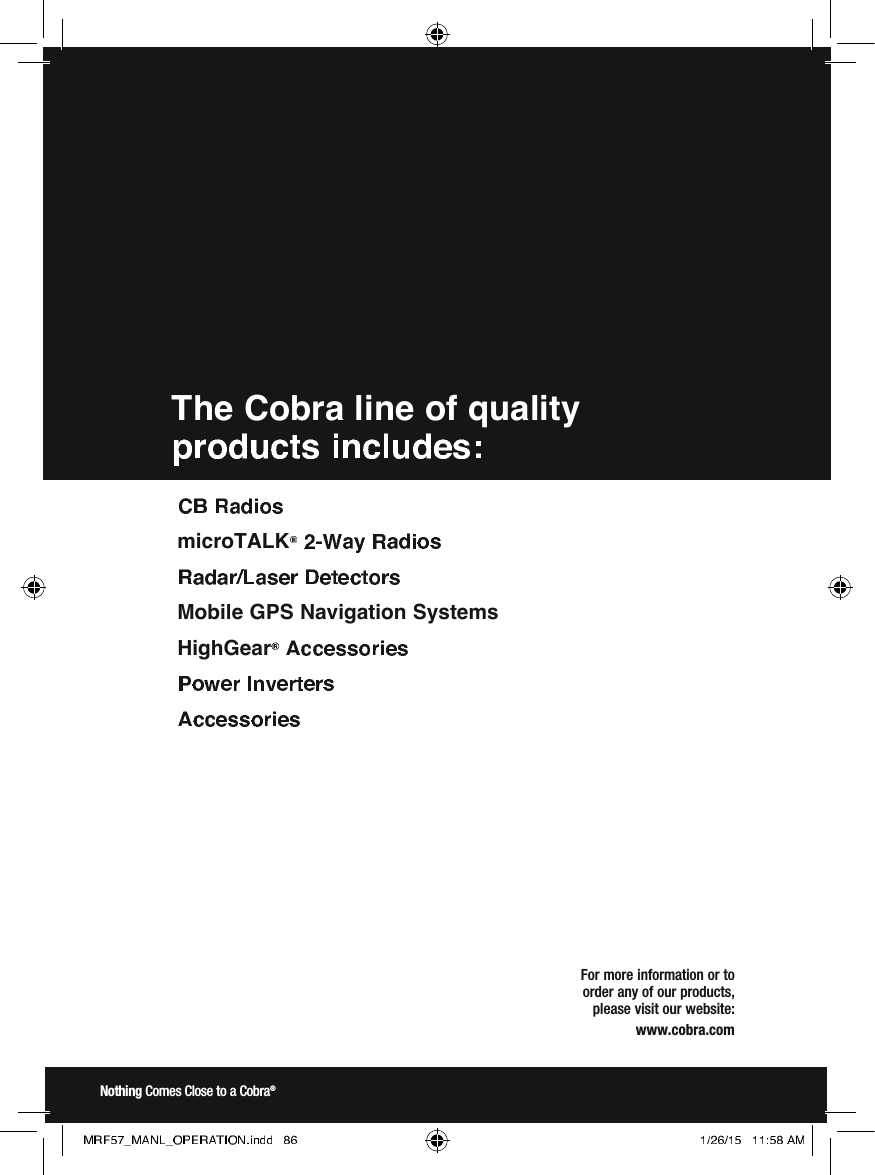Cobra Electronics MRF77 VHF Marine Radio User Manual MRF57 MANL v C
Cobra Electronics Corporation VHF Marine Radio MRF57 MANL v C
Contents
- 1. User Manual I Part 1
- 2. User Manual I Part 2
- 3. User Manual II Part 1
- 4. User Manual II Part 2
User Manual I Part 2
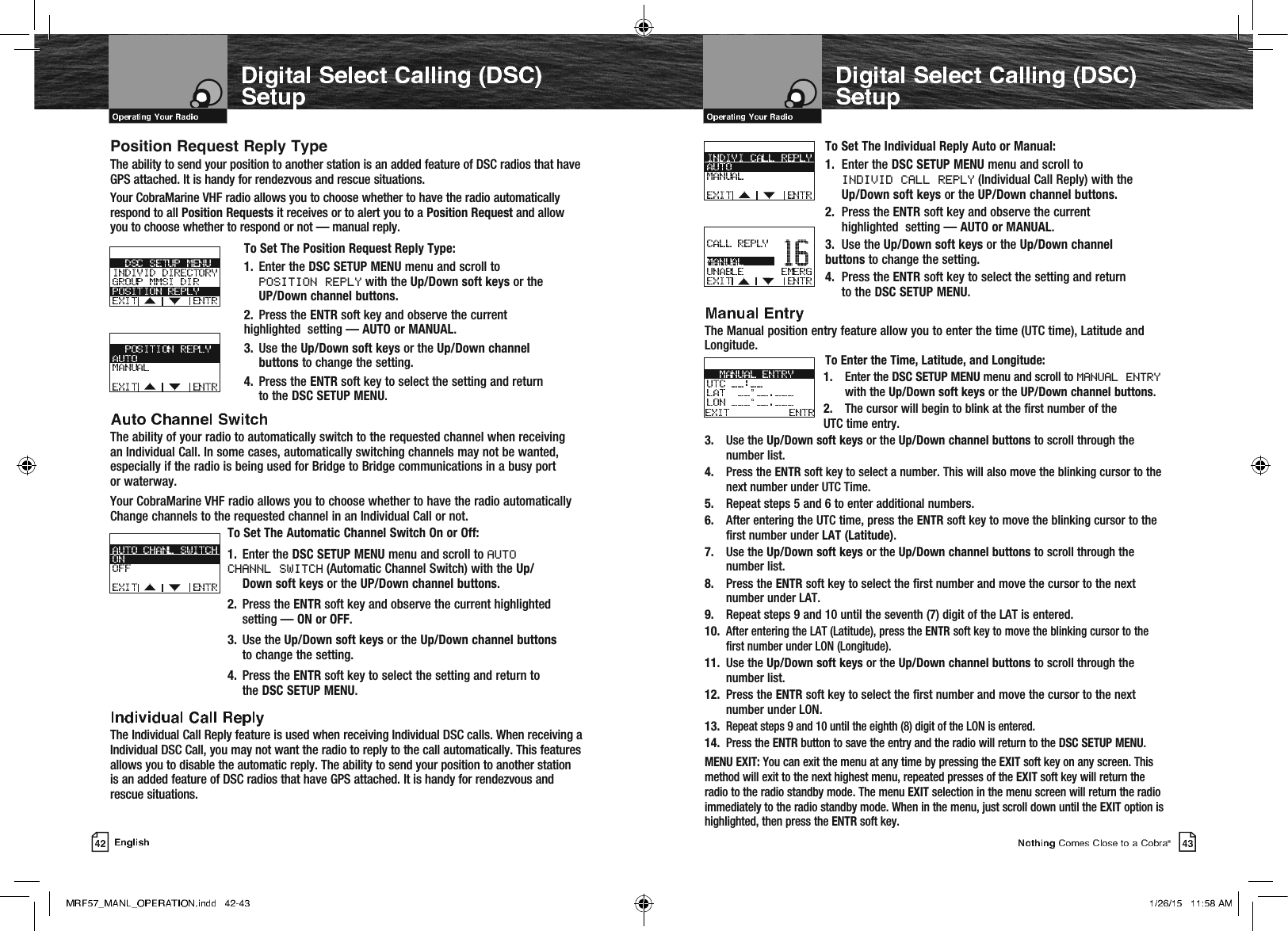
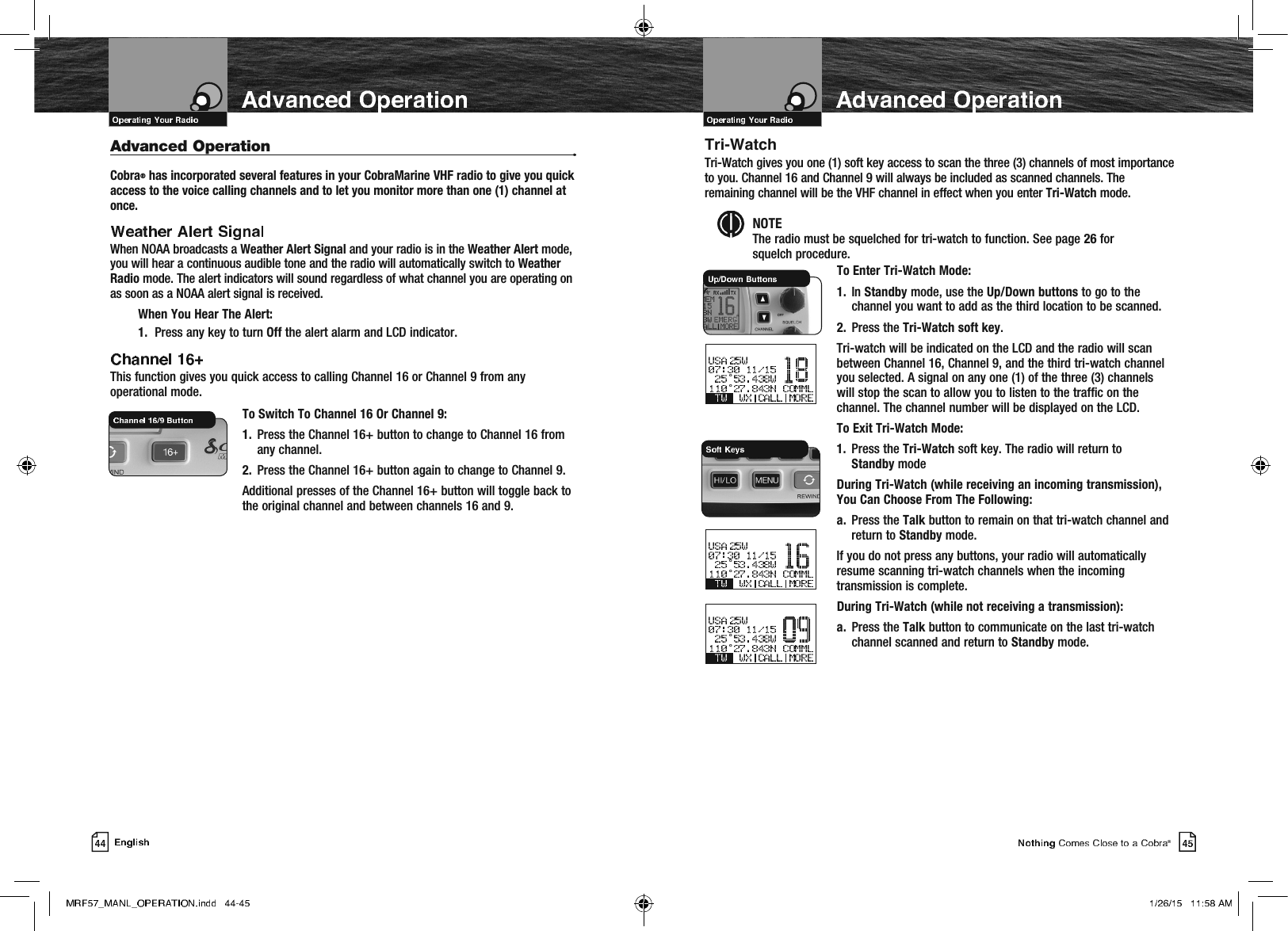
![0HPRU\&KDQQHOVYou can program (or tag) any or all channels to be scanned in the Memory Scan mode. To Program Memory Channels: 1. From Standby mode, select a channel to be tagged using the Up/Down buttons. 2. Press the MORE soft key (if necessary), then the MEM soft key. The channel will be tagged for scanning and MEM (memory channel) will appear on the LCD whenever that channel is selected. Repeat steps 1 through 2 to add addition memory channels. To Clear Memory Channels: 1. From Standby mode, select a channel to be cleared from a memory tagging using the Up/Down buttons. 2. Press and hold the MORE soft key (if necessary), then the MEM soft key. The channel will be untagged and MEM (memory channel) will no longer appear on the LCD whenever that channel is selected. Repeat steps 1 through 2 to clear additional channels from memory locations. 0HPRU\6FDQ During Memory Scan, the radio will rapidly switch from tagged channel to tagged channel. Whenever any activity is detected, the radio will stop the scan to allow you to listen to the activity on that channel. The radio will then continue to scan after 2 seconds of inactivity, unless you switch out of the Memory Scan mode.88 306075oooo NOTE If there are fewer than two (2) channels tagged, the Memory Scan mode will not be available. [See page 47 under program memory channels to tag at least two (2) channels.] NOTE The radio must be squelched for the Memory Scan mode to function. See page 26 for squelch procedure. To Enter Memory Scan: 1. From Standby mode, press the MORE soft key (if necessary), then the SCAN soft key. The radio will immediately begin to scan the channels you tagged. SCAN (memory scan) will be highlighted on the LCD. To Exit Memory Scan: 1. From Memory Scan mode, press the SCAN soft key. This will return the radio to Standby mode on the last scanned memory location. During Memory Scan (while receiving an incoming transmission), You Can Choose From The Following: a. Press the Talk button to remain on that memory location and end scanning. This will return the radio to Standby mode. The radio will then continue to scan after 2 seconds of inactivity, unless you switch out of the Memory Scan mode. During Memory Scan (while not receiving a transmission): b. Press the Talk button to communicate on the last channel scanned and return to Standby mode.6WDQGE\0RGH6WDQGE\0RGHoo](https://usermanual.wiki/Cobra-Electronics/MRF77.User-Manual-I-Part-2/User-Guide-2526489-Page-3.png)
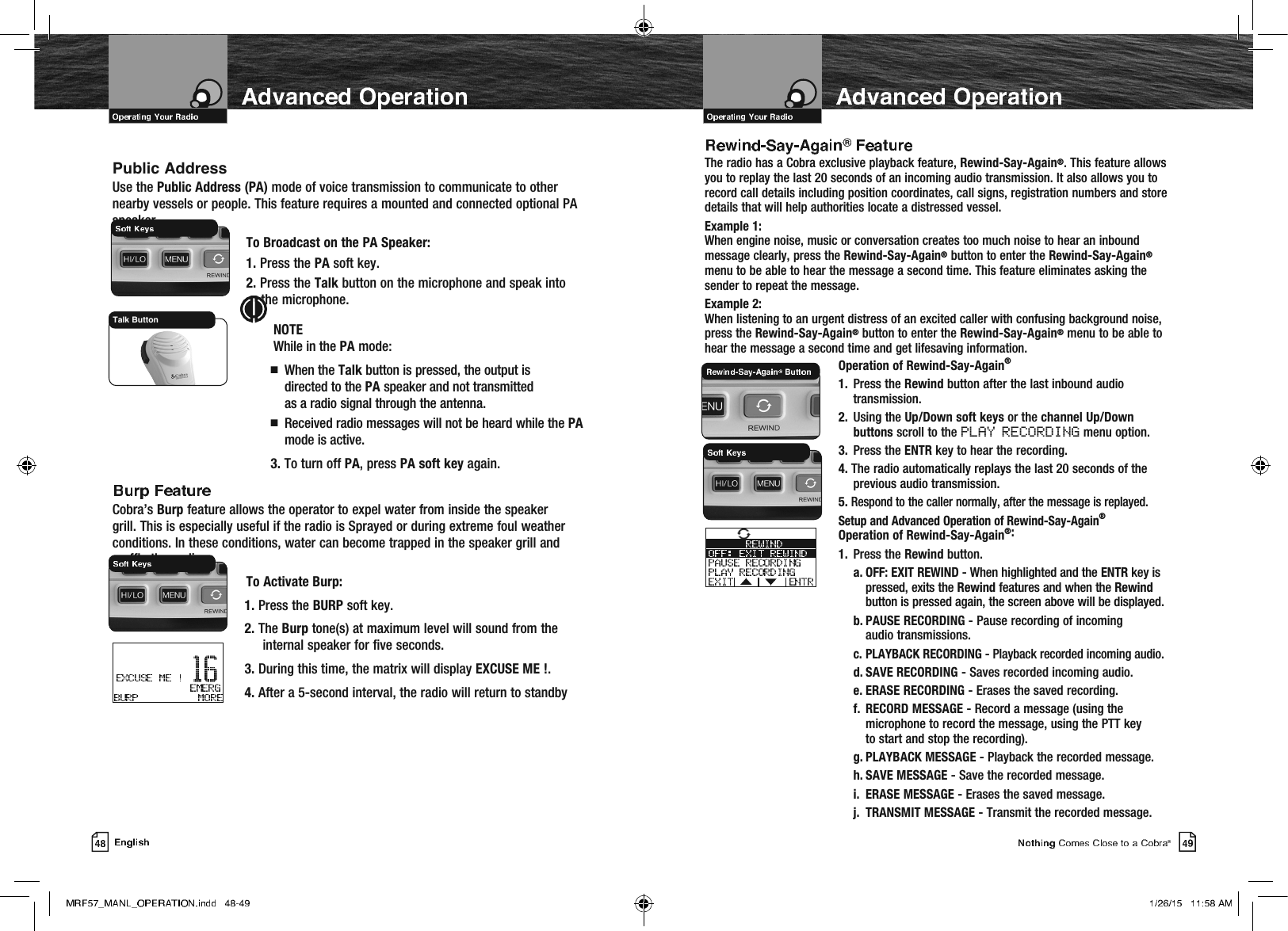
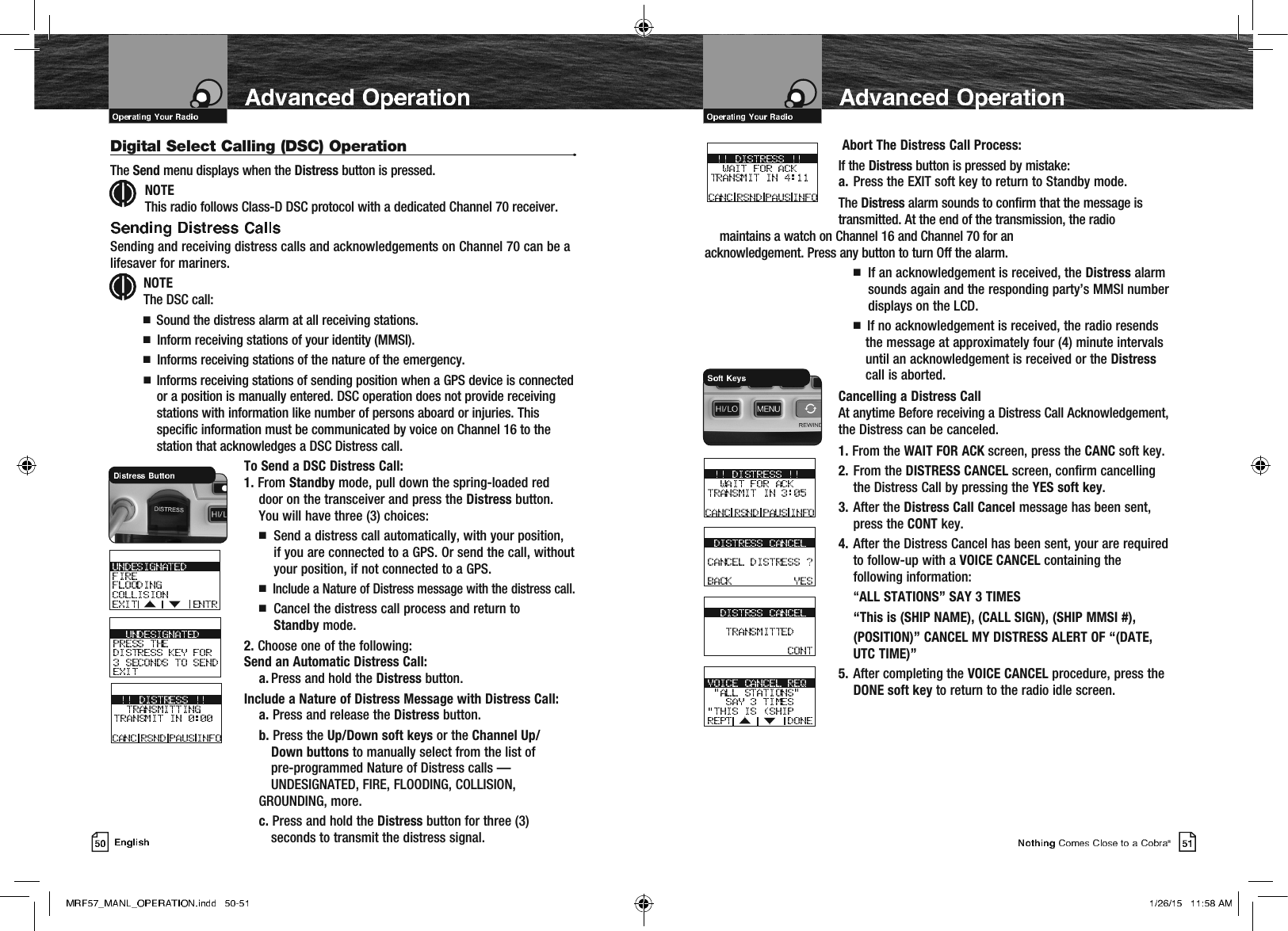
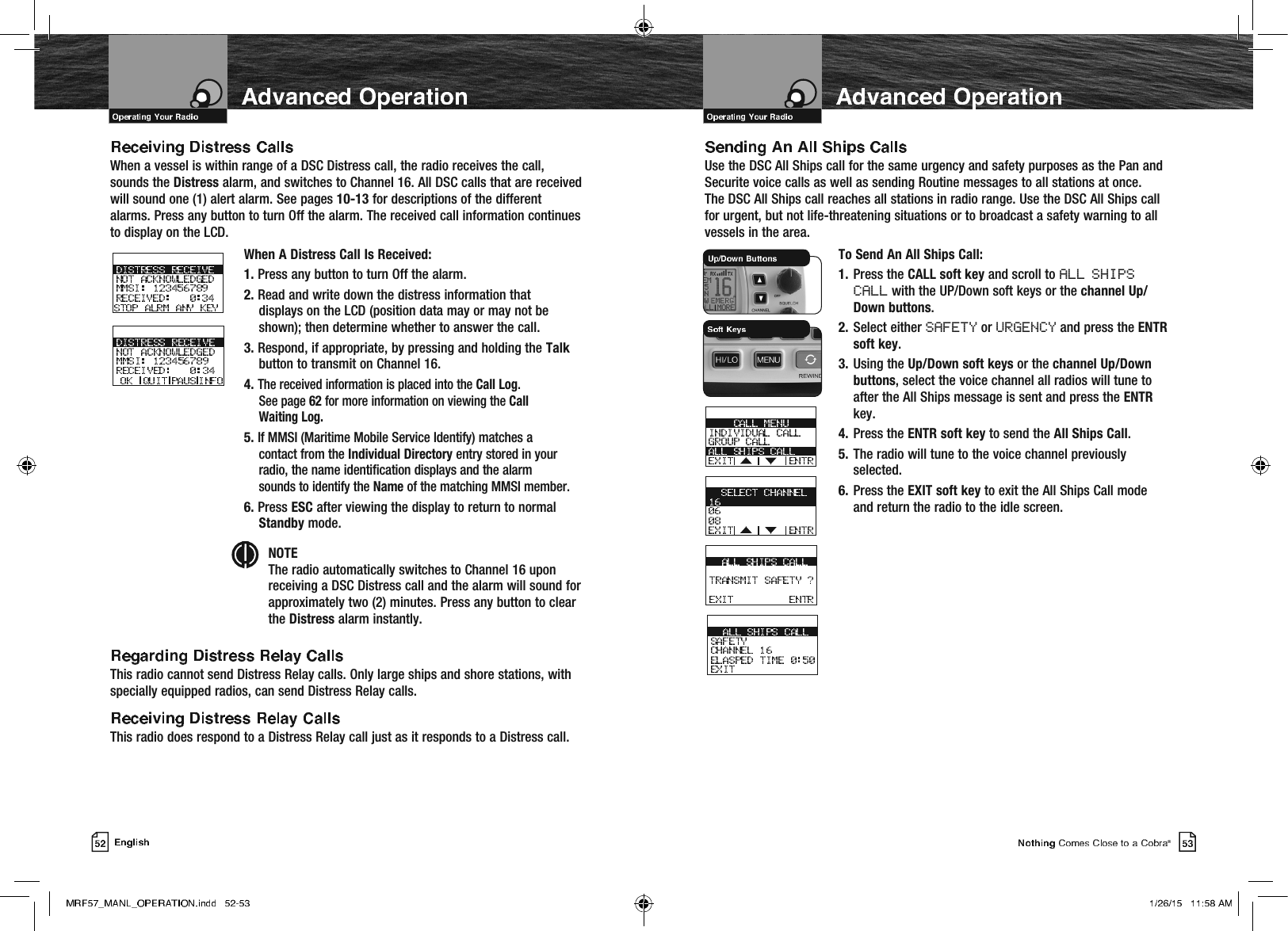
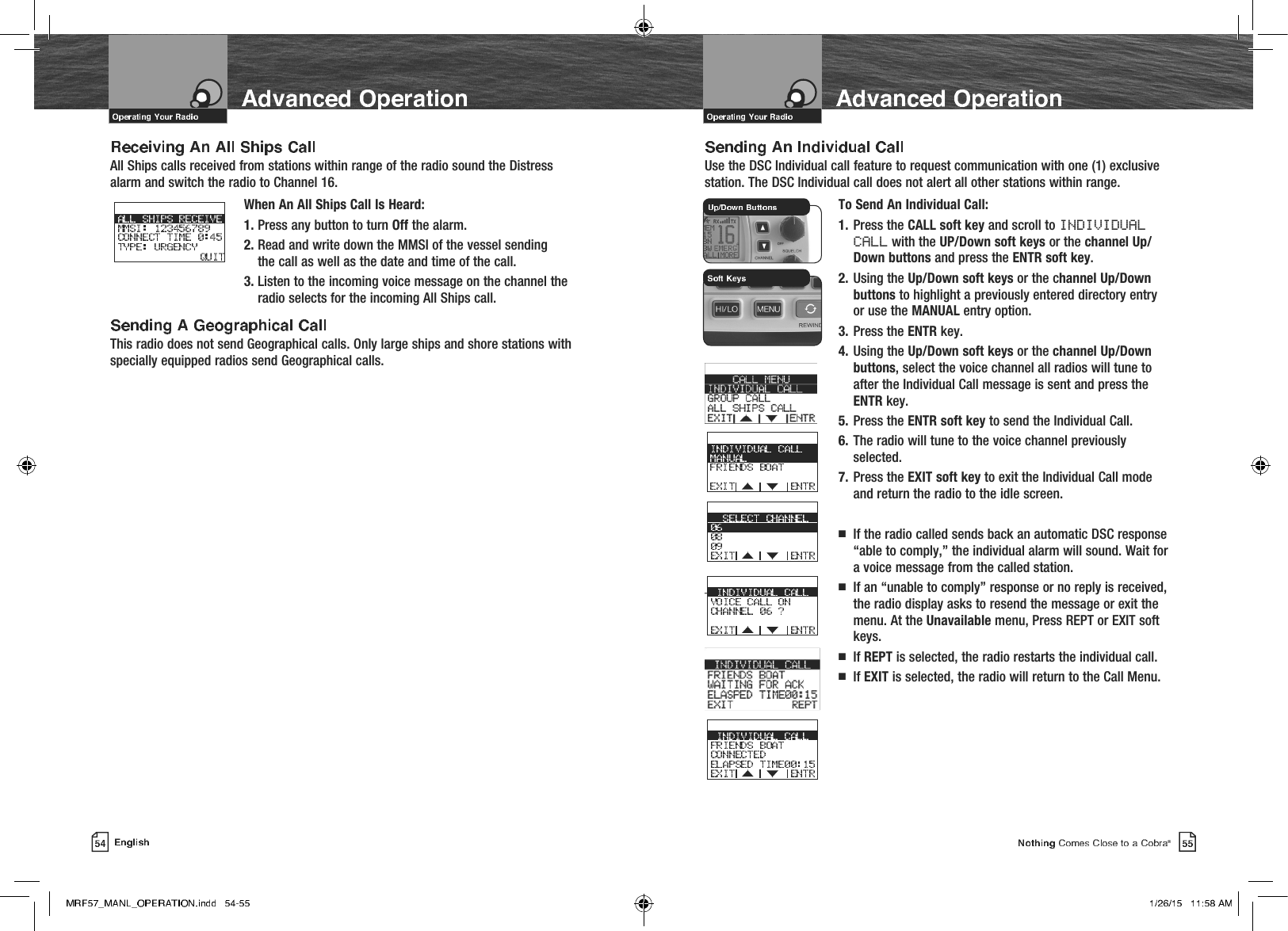
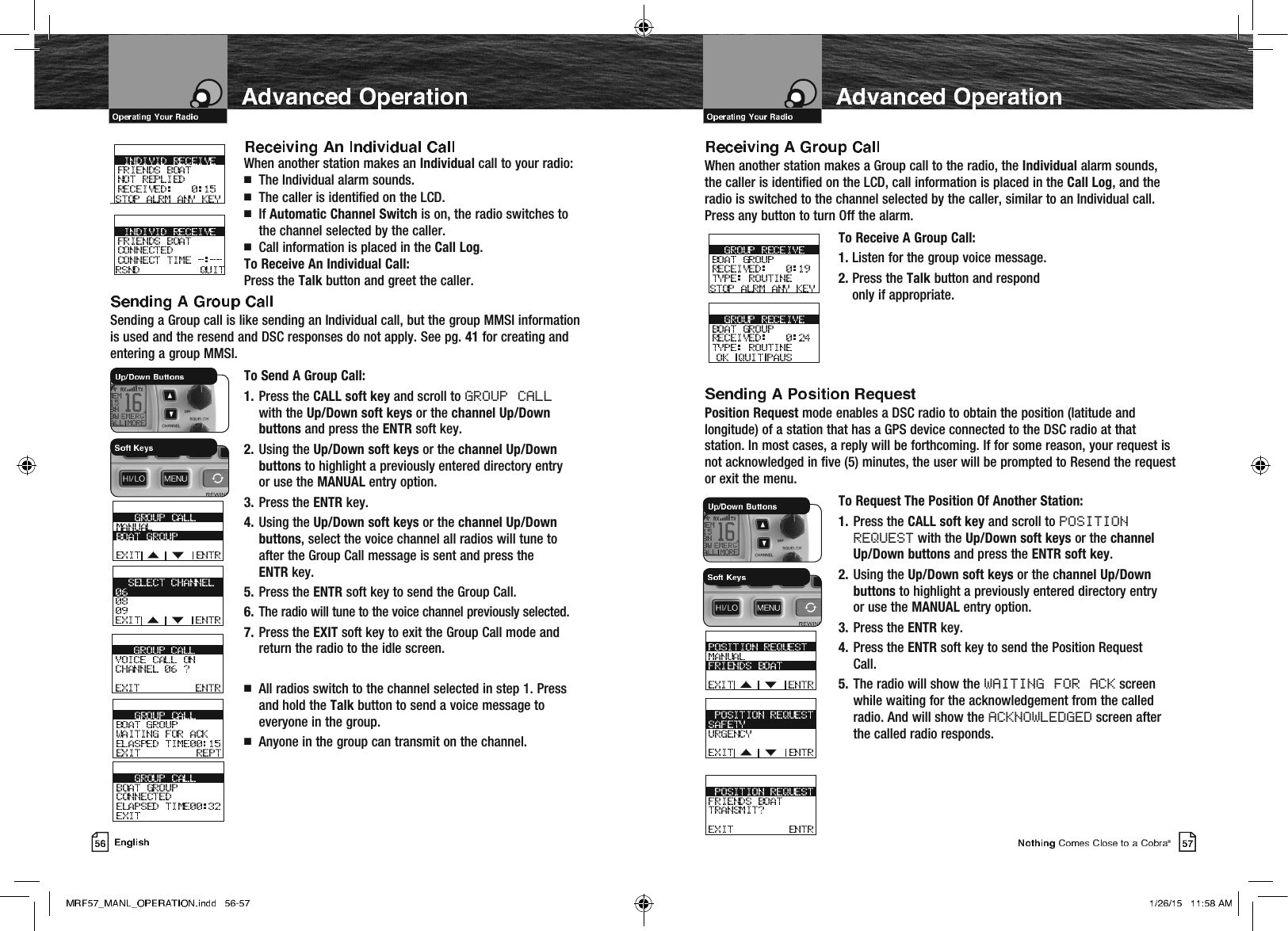
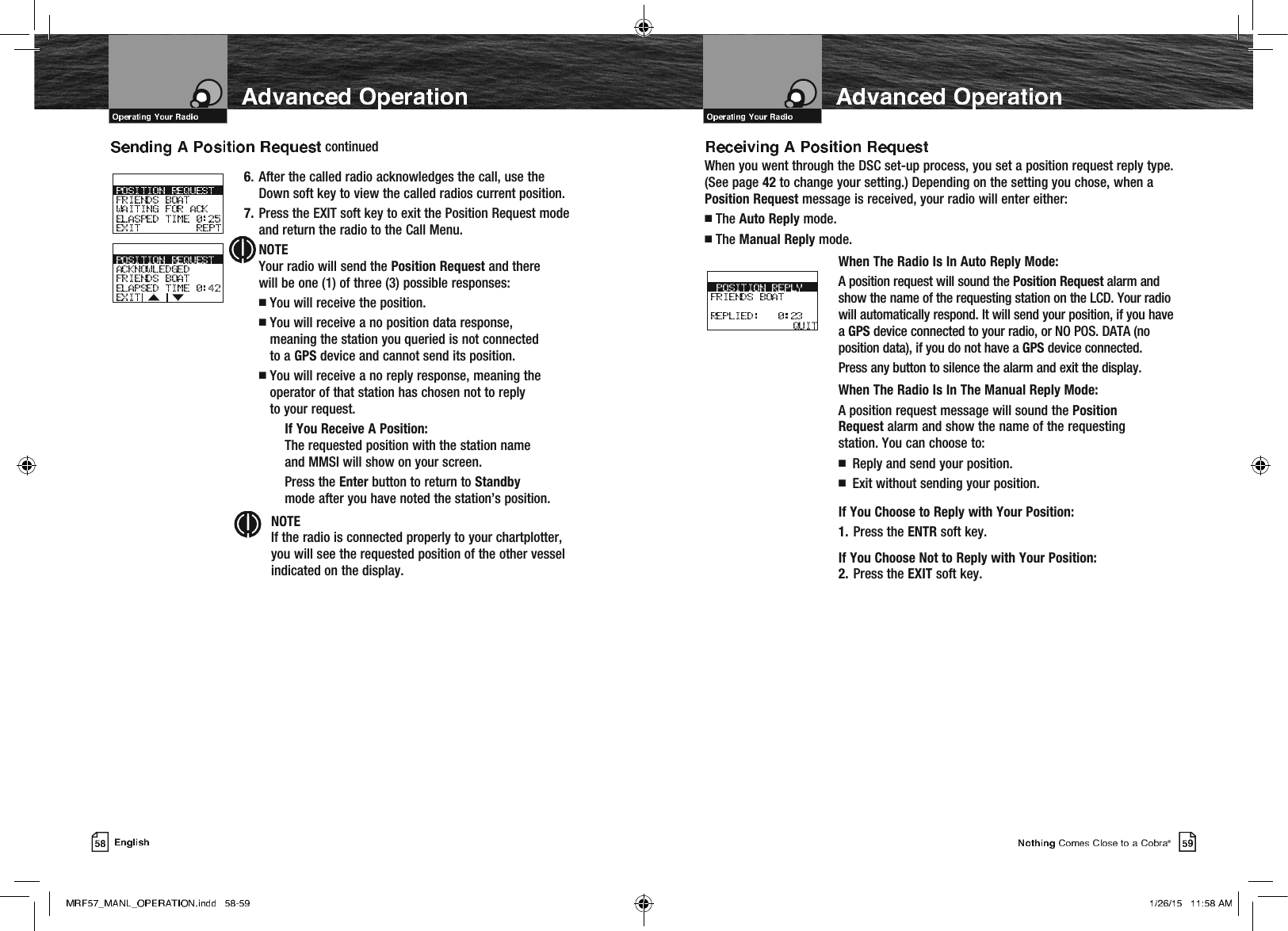
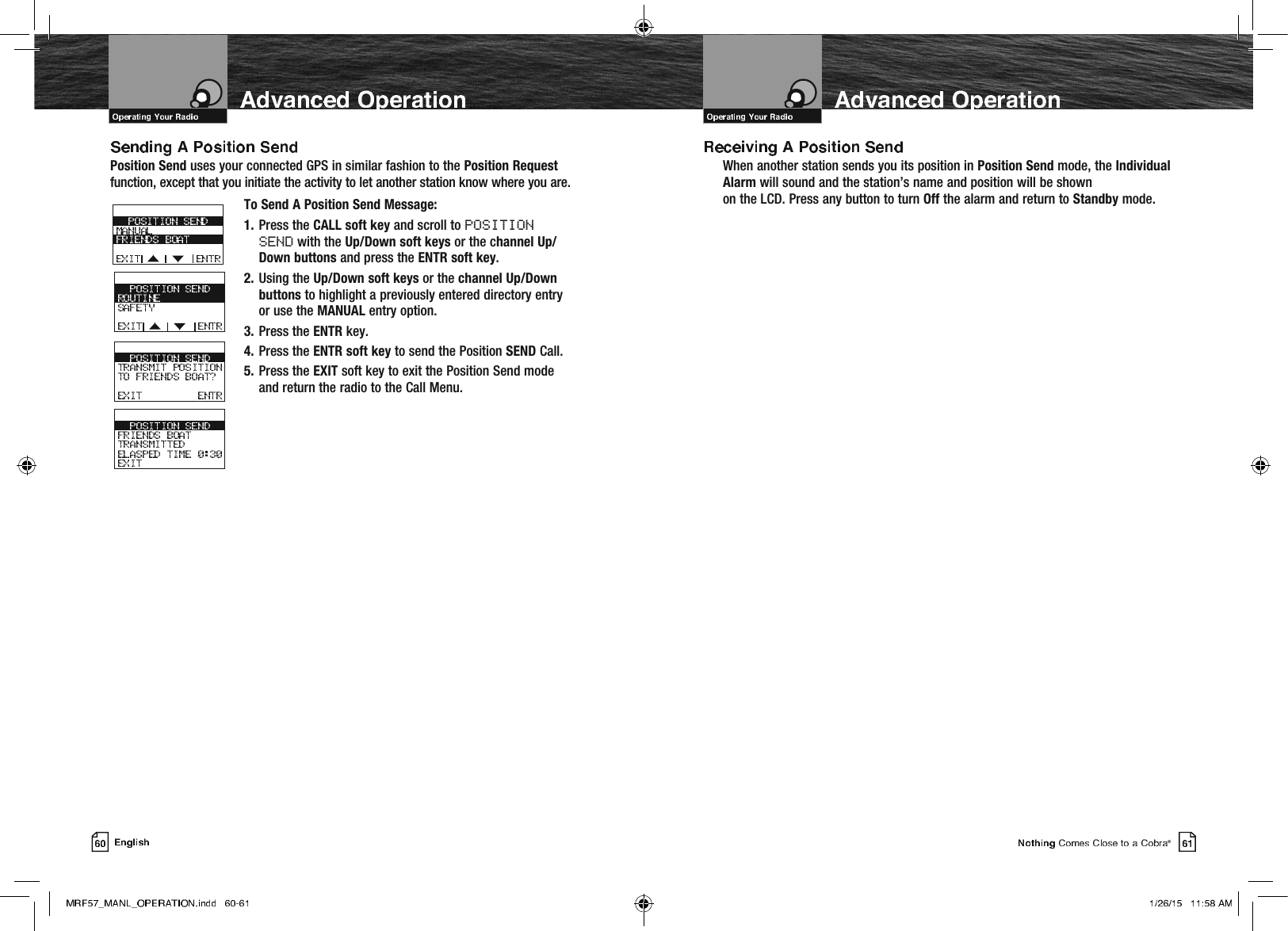
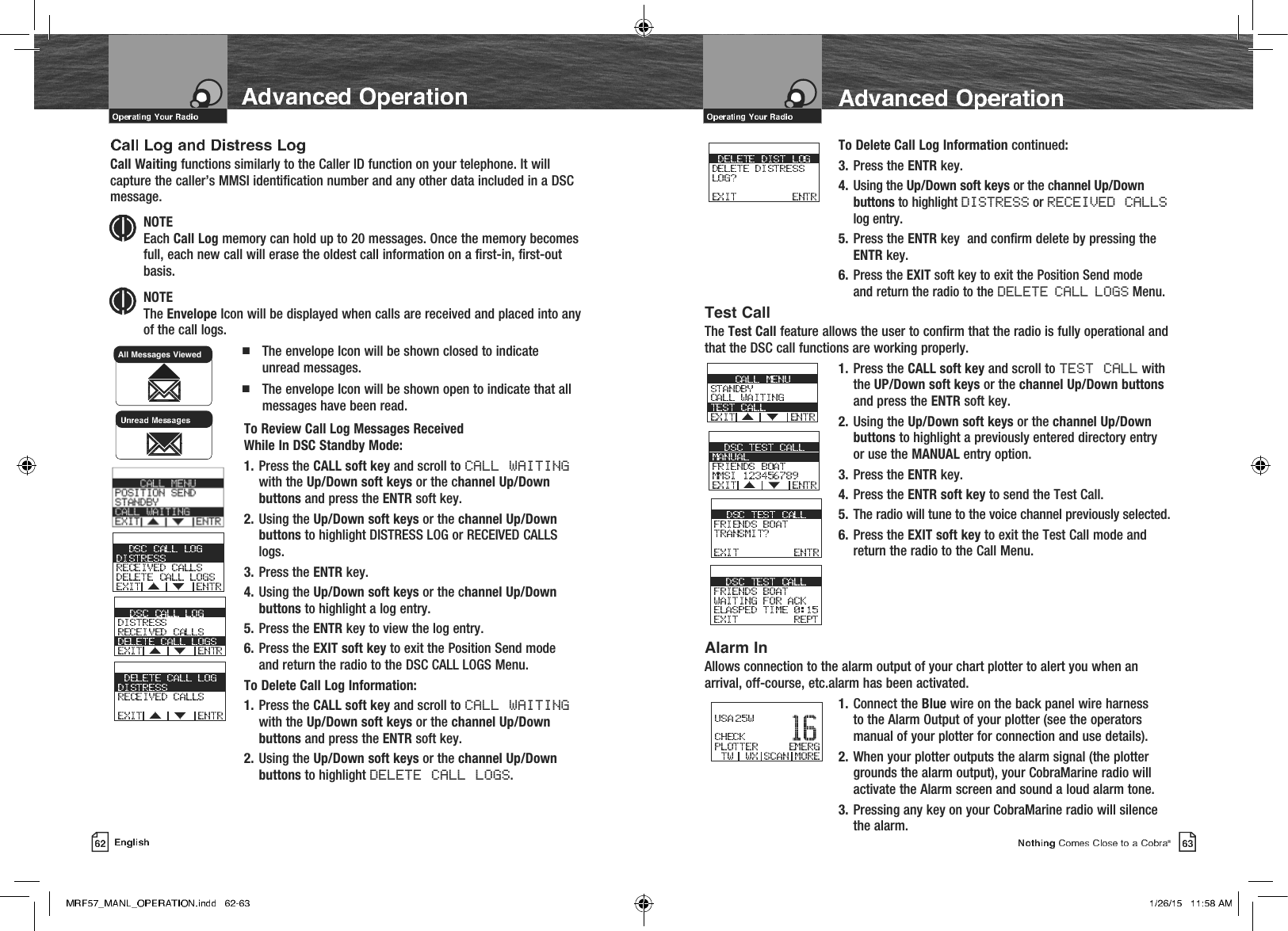
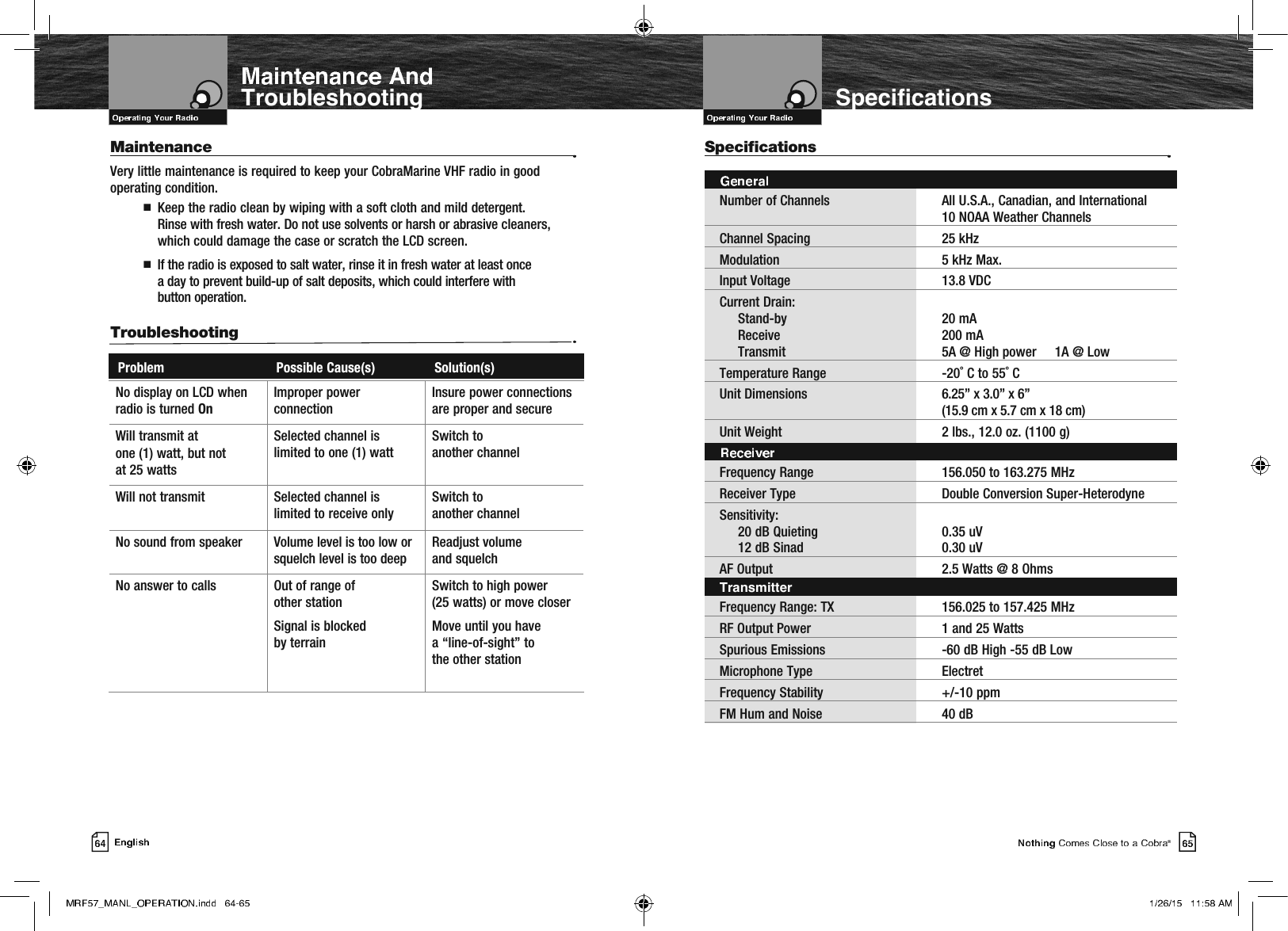
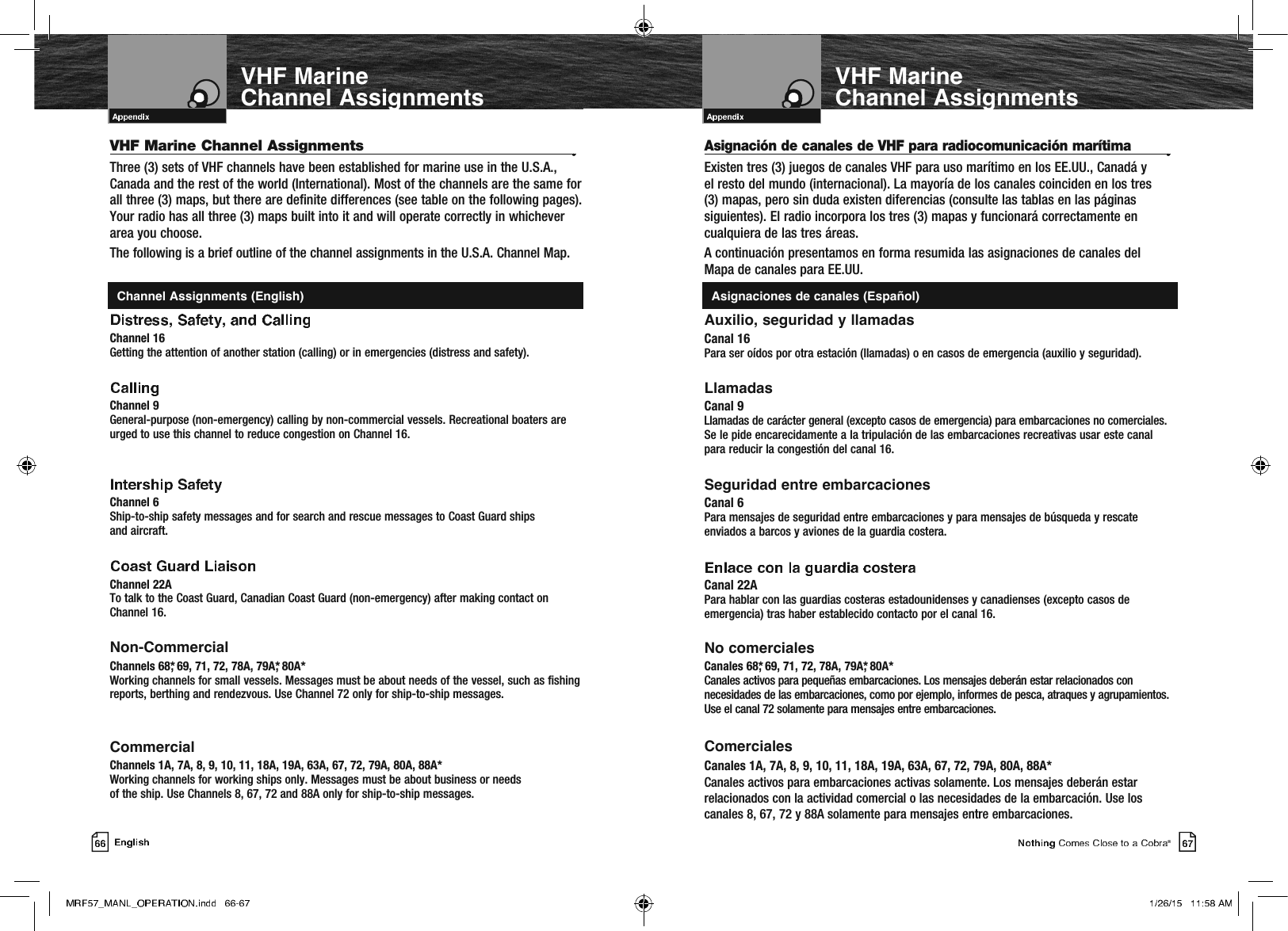
![9+)0DULQH&KDQQHO$VVLJQPHQWV9+)0DULQH&KDQQHO$VVLJQPHQWV6HD7RZ$XWRPDWHG5DGLR&KHFN$5&Channels 24, 25, 26, 27, 28, 84* Tune your radio to the proper channel for your area (see seatow.com/arc). Conduct a radio check as you normally would. Upon releasing the mic the system will replay your transmission letting you hear how you sound.Channels 1A*, 5A*, 12*, 14*, 18, 19, 20A, 21, 22, 63A*, 65A, 66A, 73, 74, 75, 76, 77*, 79, 80, 81, 82 Used for directing the movement of ships in or near ports, locks or waterways. Messages must be about operational handling, movement and safety of ships. Channels 13, 67 Channels are available to all vessels. Messages must be about navigation, including passing or meeting other vessels. These are also the main working channels for most locks and drawbridges. You must keep your messages short and power output at no more than 1 watt.0DULWLPH&RQWUROChannel 17 For talking to vessels and coast stations operated by state or local governments. Messages must be about regulation and control, boating activities, or assistance.Channel 70 This channel is set aside for distress, safety and general calling using only digital selective calling techniques. Voice communication is prohibited; your radio cannot transmit voice messages on this channel.Channels Wx 1 Thru 10 Receive-only channels for NOAA and Canadian weather broadcasts. You cannot transmit on these channels.NOTE * These channels are restricted to the listed uses in certain parts of the country or for certain types of users only. Consult FCC rules or a knowledgeable radio operator before using them.&KDQQHO$VVLJQPHQWV(QJOLVK $VLJQDFLRQHVGHFDQDOHV(VSDxRO6HD7RZ&RQWUROGHUDGLRDXWRPDWL]DGR$5&Canales 24, 25, 26, 27, 28, 84* Sintonice su radio en el canal correcto para su área (ver seatow.com/arc). Llevar a cabo una comprobación de la radio como lo haría normalmente. Al soltar el micrófono el sistema se volverá a reproducir la transmisión que le permite escuchar cómo suena.Canales 1A*, 5A*, 12*, 14*, 18, 19, 20A, 21, 22, 63A*, 65A, 66A, 73, 74, 75, 76, 77*, 79, 80, 81, 82 Usados para dirigir el movimiento de las embarcaciones dentro de áreas portuarias, esclusas o canales. Los mensajes deberán estar relacionados con maniobras operacionales, movimientos y seguridad de las embarcaciones. Canales 13, 67 Estos canales están disponibles para todas las embarcaciones. Los mensajes deberánestar relacionados con la navegación, incluidas las maniobras para pasar o alcanzar otrasembarcaciones. Éstos también son los principales canales activos para la mayoría de las esclusas y puentes levadizos. Usted deberá transmitir mensajes cortos y mantener la potencia de salida en un vatio como máximo.&RQWUROPDUtWLPRCanal 17 Para comunicarse con embarcaciones y estaciones costeras operadas por entidades gubernamentales locales o estatales. Los mensajes deberán estar relacionados con regulación y control, asistencia o actividades de navegación./ODPDGDVVHOHFWLYDVGLJLWDOHVCanal 70 Este canal está reservado para solicitudes de auxilio, seguridad y llamadas de carácter general que usen solamente técnicas de llamadas selectivas digitales. Las comunicaciones verbales están prohibidas; el radio no puede transmitir mensajes de voz por este canal.0HWHRURORJtDCanales Wx 1 a 10 Canales de recepción únicamente para difusión de información meteorológica NOAA y canadiense. Usted no puede transmitir por estos canales.NOTA * El uso de estos canales está dedicado a las aplicaciones que aparecen en la lista, en ciertas partes del país o para ciertos tipos de usuario solamente. Consulte las normas de la FCC o a un operador de radio con experiencia antes de usarlos.](https://usermanual.wiki/Cobra-Electronics/MRF77.User-Manual-I-Part-2/User-Guide-2526489-Page-14.png)
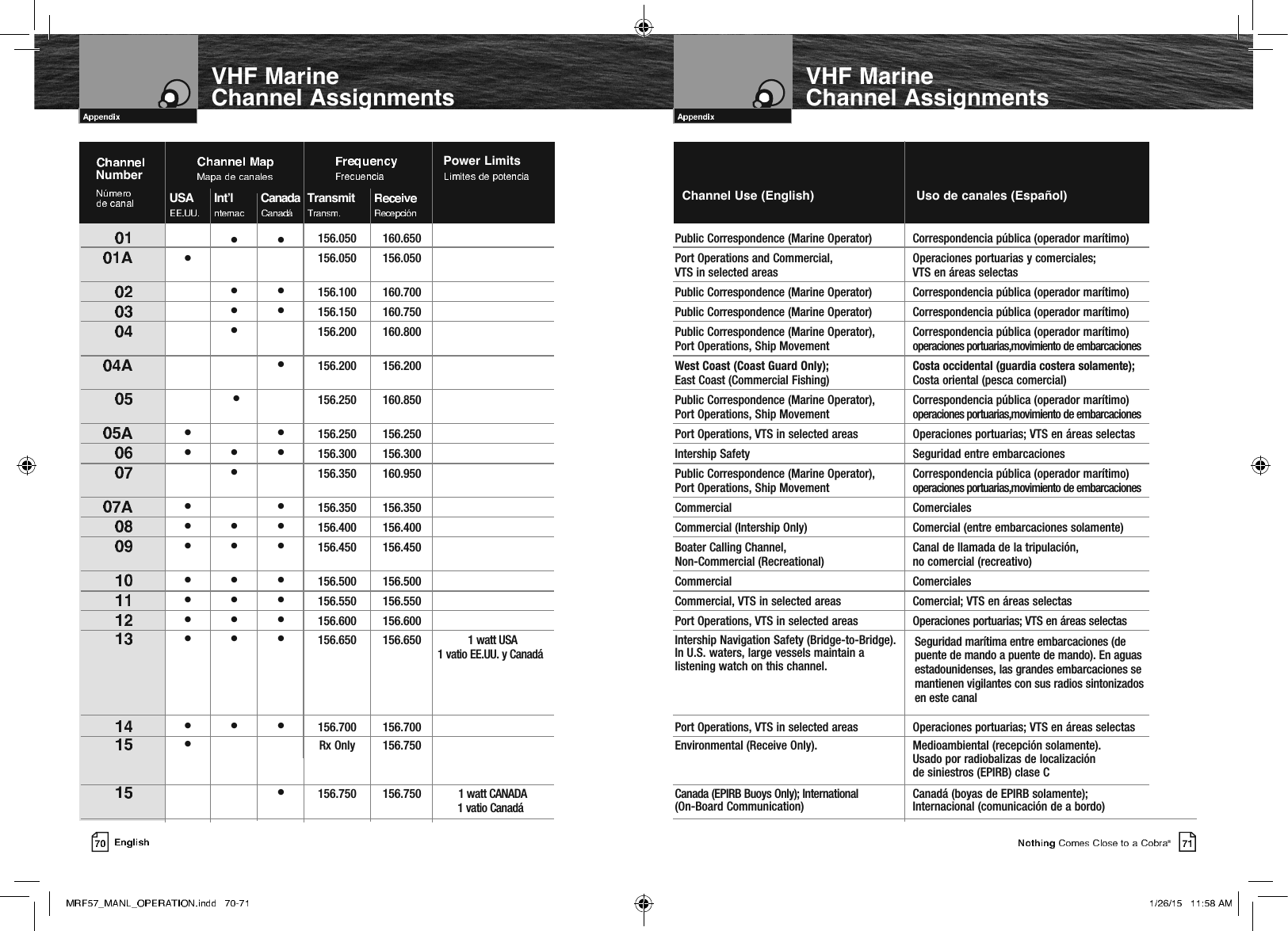
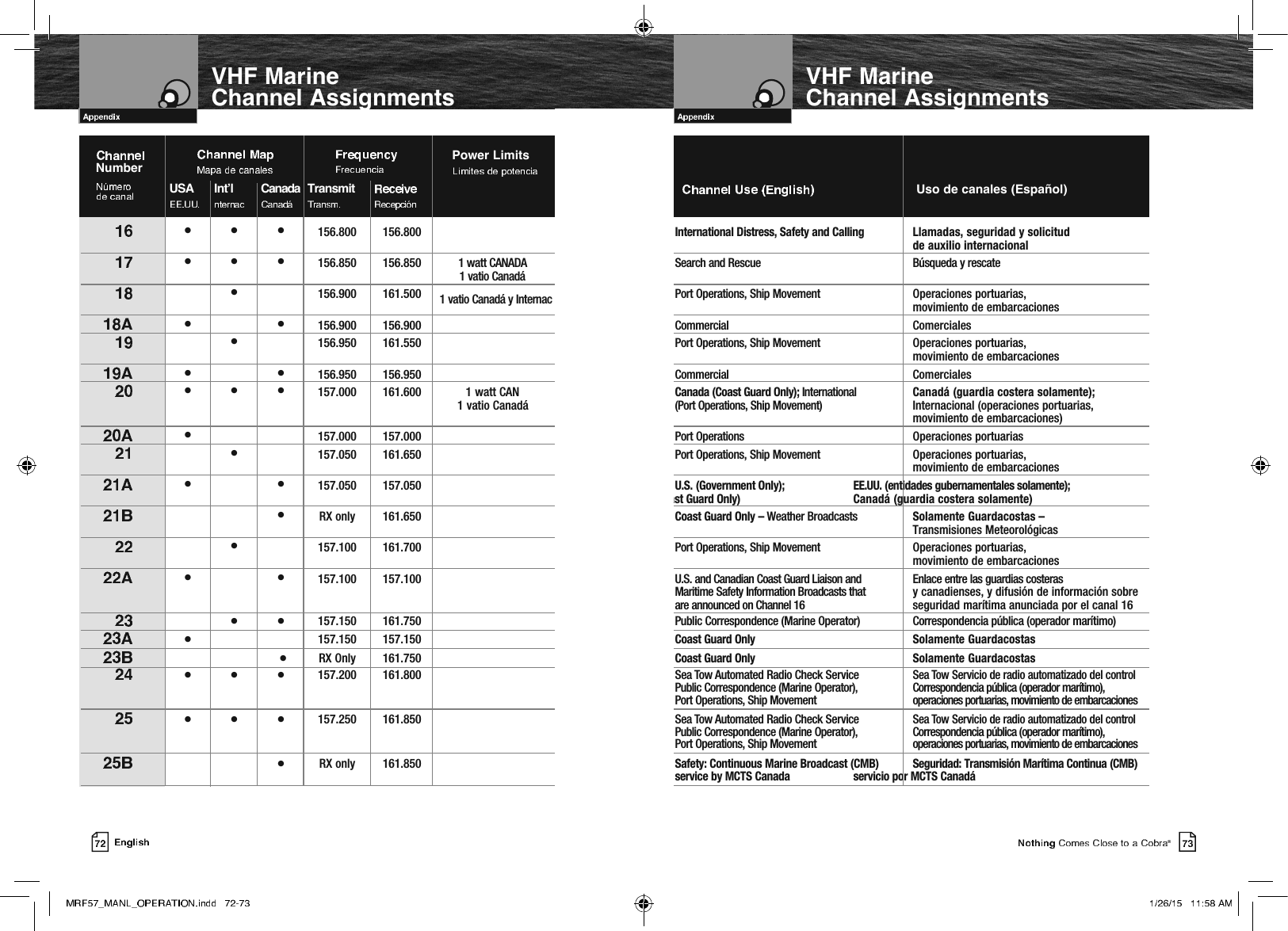
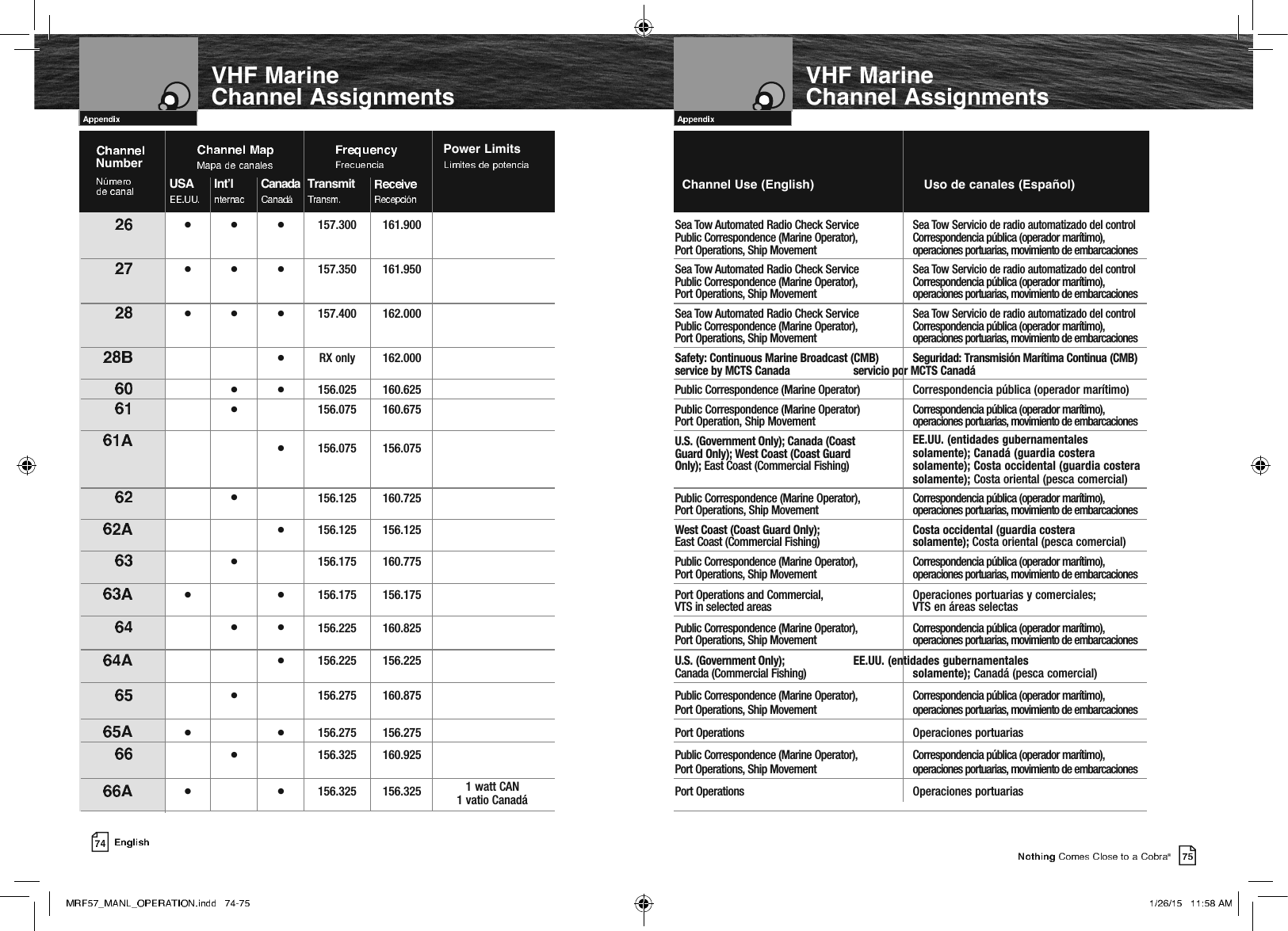
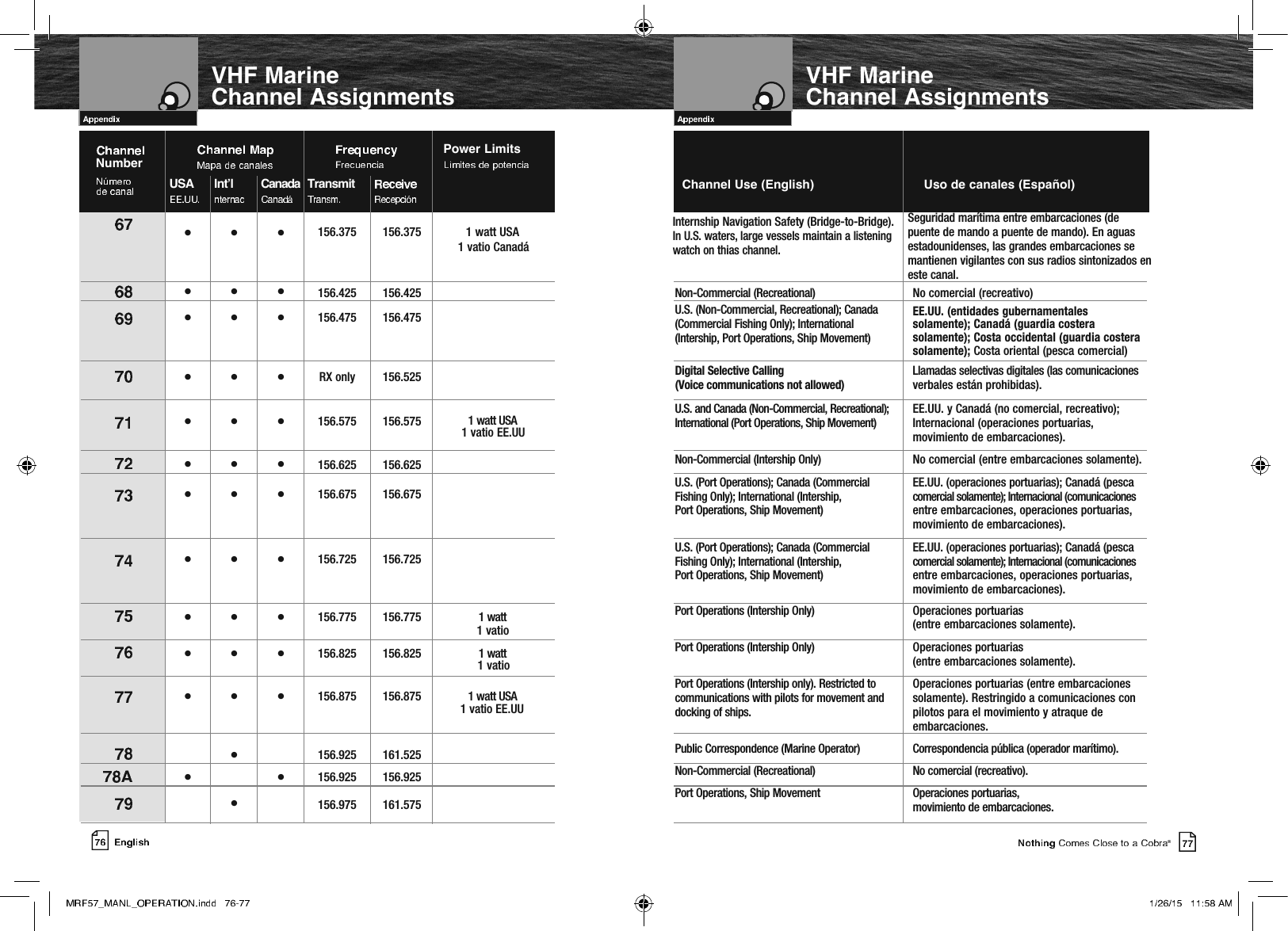
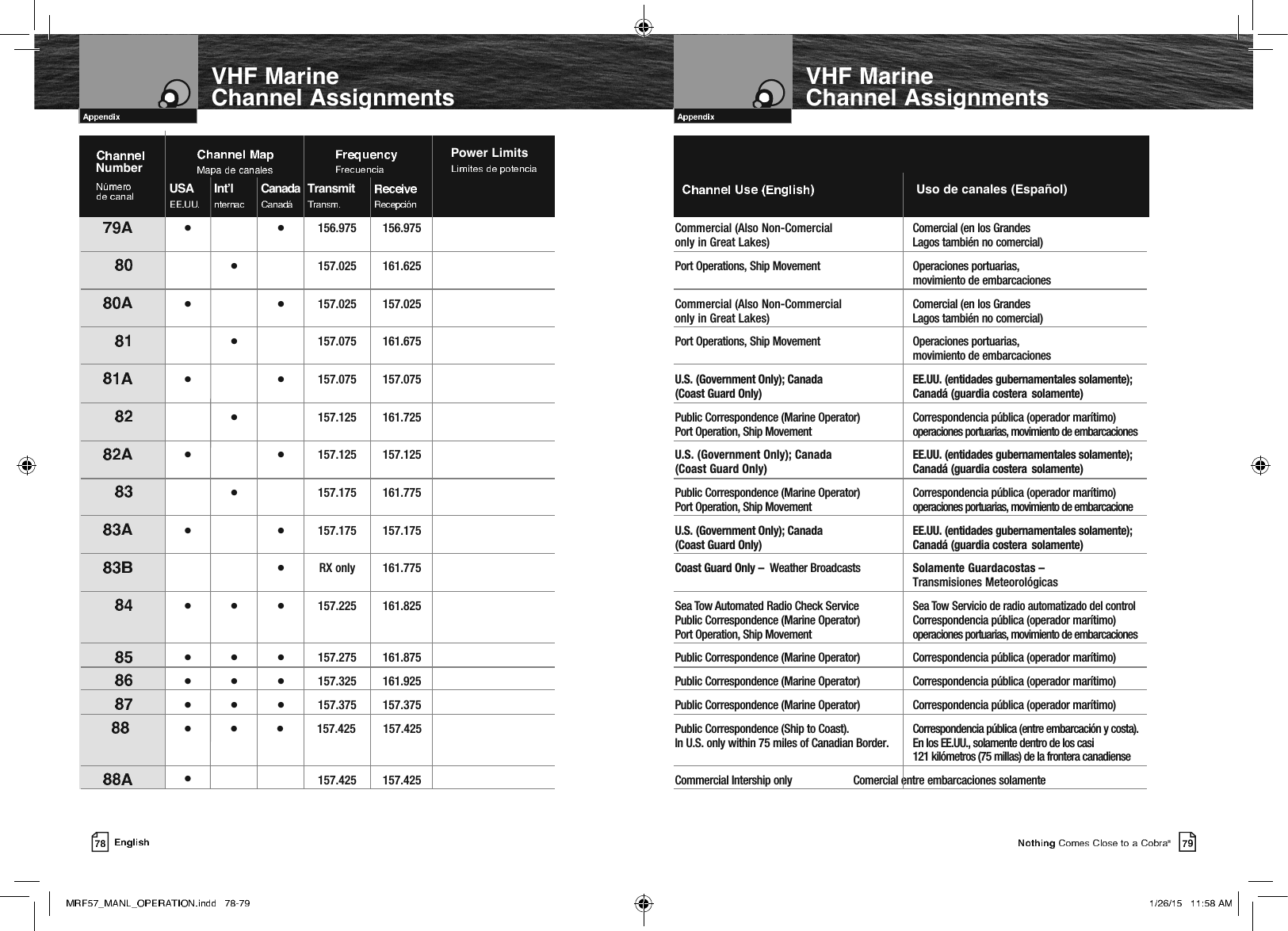
![$VVLJQPHQWV9+)0DULQH&KDQQHO$VVLJQPHQWVNOTE Many of the plain-numbered channels, such as 01, 02 and 03, transmit and receive on different frequencies. This is termed duplex operation. The rest of the plain-numbered channels and all of the A channels, such as 01A, 03A and 04A, transmit and receive on a single frequency, which is termed simplex operation. Your radio automatically adjusts to these conditions. When in simplex operation, the A icon will appear on the LCD (see illustration on page A3).NOTE All channels are preprogrammed at the factory according to international regulations and those of the FCC (U.S.A.) and Industry Canada (Canada). They cannot be altered by the user nor can modes of operation be changed between simplex and duplex. NOTA Muchos de los canales de números simples, como 01, 02 y 03, transmiten y reciben en diferentes frecuencias. A esto se le llama operación dúplex. El resto de los canales de números simples y todos los canales A, como 01A, 03A y 04A, transmiten y reciben en una sola frecuencia, a la que se le llama operación simple (simplex). Su radio se ajusta automáticamente a estas condiciones. Cuando esté en operación simple, el icono A aparecerá en la pantalla de cristal líquido (vea la ilustración de la página A3).NOTA Todos los canales vienen programados previamente de fábrica conforme a los reglamentos internacionales y a los de la FCC (EE. UU) e Industry Canada (Canadá). No pueden ser alterados por el usuario, así como tampoco pueden cambiarse los modos de operación entre simple y dúplex.Weather Channel Assignments $VLJQDFLRQHVGHFDQDOHVPHWHRUROyJLFRV 5;)UHTXHQF\0+]1XPEHU 162.550 NOAA 162.400 NOAA 162.475 NOAA 162.425 NOAA 162.450 NOAA 162.500 NOAA 162.525 NOAA 161.650 Canada 161.775 Canada 163.275 NOAA9+)0DULQH&KDQQHO$VVLJQPHQWV(QJOLVK$VLJQDFLyQGHFDQDOHVGH9+)SDUDUDGLRFRPXQLFDFLyQPDUtWLPD(VSDxRO](https://usermanual.wiki/Cobra-Electronics/MRF77.User-Manual-I-Part-2/User-Guide-2526489-Page-20.png)
